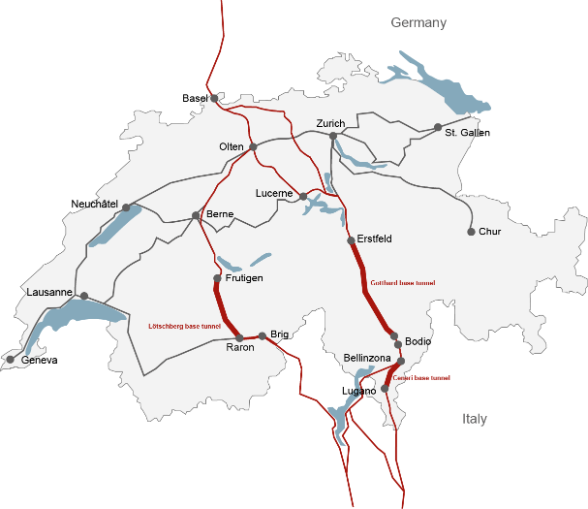The NRLA (New Rail Link through the Alps) consists of three base tunnels and their access routes. These run through the Alps at the level of the Swiss Plateau and have replaced the existing mountain routes, with their considerable differences in height, as the main transport axes.
NRLA’s constituent parts
Lötschberg Base Tunnel
The Lötschberg Base Tunnel is 34km long and has been in operation since 2007. It stretches from the Bernese Oberland to the Valais. From there the route continues to northern Italy via the Simplon tunnel. Construction took eight years and costed around CHF 5.3 billion (current costs including interest and VAT). The Lötschberg Base Tunnel consists of two separate tubes, apart from one section of the western tube of around 6km. To save money, only one third of the tunnel was initially developed with dual tracks. The remainder of the second tube serves as a rescue tunnel. In 2019 Parliament approved the completion of the remaining part of the second tube as part of the 2035 expansion step, costing around CHF 0.9 million. The Lötschberg Base Tunnel has shortened journey times between major destinations in German-speaking Switzerland and the Valais and northern Italy by up to one hour. Passenger trains travel every hour (and every half hour at peak times) through the Lötschberg Base Tunnel. It is also very important for freight traffic: the Lötschberg Base Tunnel can handle up to 110 freight trains every day.
Gotthard Base Tunnel
At 57km, the Gotthard Base Tunnel has overtaken the Seikan tunnel in Japan (53.8km) as the world’s longest rail tunnel. With 2,300m of rock above it, it is also the world’s deepest mountain tunnel. The Gotthard Base Tunnel consists of two fully developed, separate tubes, and shortens the mountain route between the cantons of Uri and Ticino by around 30km. The tunnel has been in use since December 2016 and up to 260 freight trains can travel through it every day. A half-hourly regular timetable will be introduced for passengers. The cost of the Gotthard Base Tunnel is running at CHF 12.2 billion (current costs including interest and VAT). The immense significance of the Gotthard Base Tunnel was demonstrated on the occasion of its grand opening on 1 June 2016, at which the heads of state and government leaders from all neighbouring countries, the EU transport commissioner and the entire Swiss Federal Council were represented.
Ceneri Base Tunnel
The 15.4km Ceneri Base Tunnel in the canton of Ticino completes the Gotthard axis. It cost CHF 3.6 billion (current costs including interest and VAT) and entered service at the end of 2020. The Ceneri Base Tunnel consists likewise of two fully developed separate tunnels. The Gotthard and Ceneri Base Tunnels will reduce journey time from Zurich to Lugano by up to 45 minutes. In the medium term the journey to Milan will be an hour shorter, thanks to the NRLA. The Ceneri Base Tunnel makes the regional rail network of Ticino much more attractive by massively reducing journey times and considerably improving connectivity.





